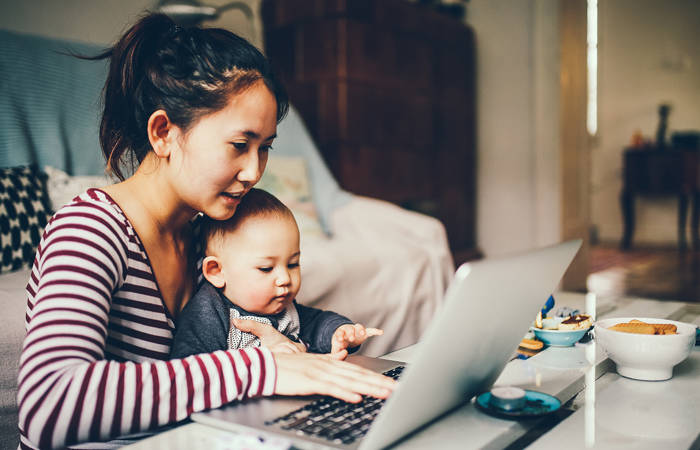Like what you see?
Sign up to receive more free parenting advice.
Thank you for subscribing to our newsletter!
Lifestyle

Credit: iStock.com/monkeybusinessimages
It’s been ten years since Australia first introduced its federally funded Paid Parental Leave (PPL) scheme offering a payment for up to 18 weeks while you care for your baby.
The scheme provides up to 90 payable days at a weekly rate matching the national minimum wage for the primary carer. Eligible working partners (including same-sex partners) get two weeks leave paid at the national minimum wage.
But the CEO of Parents at Work, Emma Walsh, says we have seen far too few improvements to the scheme in the last decade and it’s not keeping pace with international standards.
“In many nations, paid parental leave is seen as a vital lever to support workforce participation. In Australia we’re lagging behind. We offer one of the least generous schemes. The OECD average is 53 weeks PPL. Australia pays 18 weeks,” Emma says.
“It’s also highly gendered and rigid in its design, making it difficult for families to access and share the leave flexibly. [Those decisions are] at odds with modern family and workplace needs and expectations. The policy is out of step; it’s exclusive not inclusive.
“PPL was introduced during the global financial crisis and was announced as just the starting point for a policy that would only get better,” Emma says.
She says since PPL’s launch there has been no attempt to extend the number of weeks it’s available for, no superannuation paid on the leave, no move towards a scheme that’s more evenly shared between both parents (the push is still very much on having one ‘primary carer’ who accesses the bulk of the payment); and no tie in with a broader national work and family policy framework to progress the way we combine work and care.
In many nations, paid parental leave is seen as a vital lever to support workforce participation. In Australia we’re lagging behind. We offer one of the least generous schemes. The OECD average is 53 weeks PPL. Australia pays 18 weeks.Emma Walsh
Stay up to date with the latest news and articles from First Five Years
Thank you for subscribing to our newsletter!
Looking to international best practice
Given Australia’s declining birth rate and persistent gender inequality gap, Emma says she is perplexed by the policy direction on parental leave.
“Currently Australia doesn’t have any guiding principles or policy framework to address the way we combine work and care needs for the benefit of our community and economy. For example PPL and childcare policies have been designed in isolation without much thought how the two policies interact and work hand in hand to drive improved workforce participation, early childhood development and gender equality outcomes,” she says.
Emma says that by coming late to the PPL party, Australia has the opportunity to pick and choose from the best policies, tried and tested in other countries, but unfortunately she believes there appears to be no appetite to progress the current status quo, despite comparable nations making incremental improvements.
“New Zealand increased its paid parental leave entitlement from 18 weeks in two stages: to 22 weeks from July 1, 2018, and then to 26 weeks from July 1, 2020,” Emma says.
She also points to the UK, where a shared PPL scheme introduced in 2015 means it’s much easier for two parents or carers to split the leave.
“To me there is no excuse for not looking at what other countries have been doing and laying out a progressive plan for the future,” Emma says.
Women in the workforce
While female participation in the workforce has continued to climb, Emma says the figures only tell part of the story.
“It’s good to see a rise in mothers returning to the workforce but if you look at a woman’s hours of work and career trajectory, when she becomes a mother there is still a huge disruption that occurs.
“Australian Institute of Family Studies data shows a very stark graph. When a man becomes a father, his pattern of working hours typically does not change at all when he becomes a parent. For a woman, the data is like a seismologist’s report and their hours are all over the place.
“The data suggests that mothers’ working hours don’t typically bounce back to pre-baby work patterns in the short or longer term. We also have one of the largest female part-time workforces in the world. All of that obviously has a flow on effect for promotional opportunities, salary and superannuation,” Emma says.
Gender inclusive policies
Emma would like to see Australia’s PPL scheme modernised by making it more flexible and gender equal, allowing both parents the ability to share care more easily.
She believes this simple shift would avoid setting up the mother as the ‘default’ primary caregiver.
“I’ve seen models in other European countries with nine months in total leave - three for one parent, three for the other parent, and three months that can be shared. There are also many countries where PPL is used as flexibly as annual leave. People can take it a day at a time rather than a block, which would make it easier for childcare and easier for fathers to take it,” Emma says.
She says some of the most progressive PPL changes in Australia are being led by organisations offering a gender-inclusive policy.
“Deloitte offers all new parents 18 weeks and have removed the labels ‘primary’ and ‘secondary’ carer from their policy. You have three years to use it and you can access it flexibly. Telstra, ING and QBE have also all removed the labels and offer extended ability to access the leave flexibly beyond the first 12 months. You choose what works for your family,” Emma says.
Emma would also like to see a 10-year plan for improving Australia’s PPL scheme, but getting there may require a much-needed attitudinal shift.
“We need to stop thinking of paid parental leave as a welfare payment or a lifestyle choice that parents make. I think we all understand the concept and benefit of annual leave. We all broadly support that it’s needed, warranted and important for people's physical and mental health.
“Same goes for providing sick leave when people are not well, or need time to recover. So why is the concept of providing paid parental leave still seen by some as contentious when people have a baby?”.
History of women in the Australian workforce
- In 1966 the Marriage Bar was removed. This law meant Australian women had to give up their job once they got married.
- In 1983 Australia signed the Convention on the Elimination of all Forms of Discrimination Against Women.
- Still, inequality remains. According to the Australian Government’s Workplace Gender Equality Agency1:
- Women make up 37.6% of all full-time employees and 67.9% of all part-time employees.
- The full-time average weekly ordinary earnings for women are 14.0% less than for men (or more, depending on how the data is carved up).







